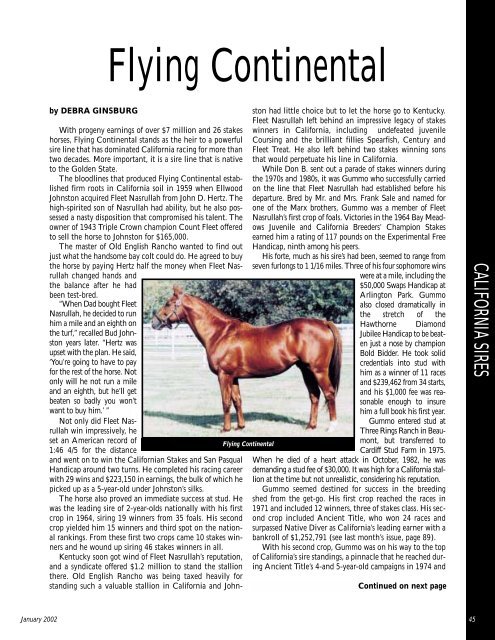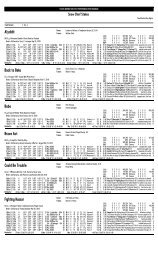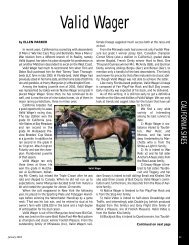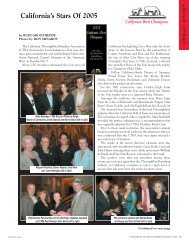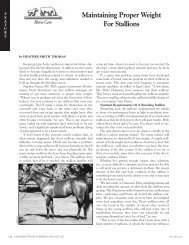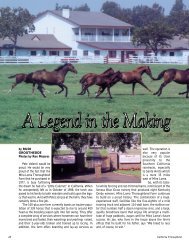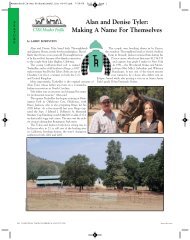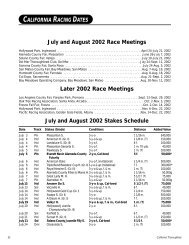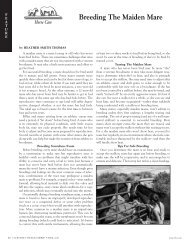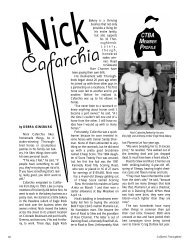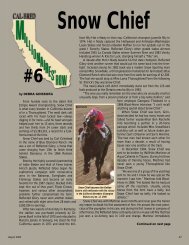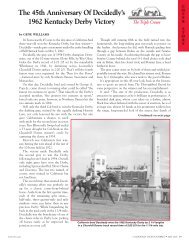Flying Continental - California Thoroughbred Breeders Association
Flying Continental - California Thoroughbred Breeders Association
Flying Continental - California Thoroughbred Breeders Association
- No tags were found...
Create successful ePaper yourself
Turn your PDF publications into a flip-book with our unique Google optimized e-Paper software.
<strong>Flying</strong> <strong>Continental</strong>by DEBRA GINSBURGWith progeny earnings of over $7 million and 26 stakeshorses, <strong>Flying</strong> <strong>Continental</strong> stands as the heir to a powerfulsire line that has dominated <strong>California</strong> racing for more thantwo decades. More important, it is a sire line that is nativeto the Golden State.The bloodlines that produced <strong>Flying</strong> <strong>Continental</strong> establishedfirm roots in <strong>California</strong> soil in 1959 when EllwoodJohnston acquired Fleet Nasrullah from John D. Hertz. Thehigh-spirited son of Nasrullah had ability, but he also possesseda nasty disposition that compromised his talent. Theowner of 1943 Triple Crown champion Count Fleet offeredto sell the horse to Johnston for $165,000.The master of Old English Rancho wanted to find outjust what the handsome bay colt could do. He agreed to buythe horse by paying Hertz half the money when Fleet Nasrullahchanged hands andthe balance after he hadbeen test-bred.“When Dad bought FleetNasrullah, he decided to runhim a mile and an eighth onthe turf,” recalled Bud Johnstonyears later. “Hertz wasupset with the plan. He said,‘You’re going to have to payfor the rest of the horse. Notonly will he not run a mileand an eighth, but he’ll getbeaten so badly you won’twant to buy him.’ ”Not only did Fleet Nasrullahwin impressively, heset an American record of1:46 4/5 for the distanceand went on to win the <strong>California</strong>n Stakes and San PasqualHandicap around two turns. He completed his racing careerwith 29 wins and $223,150 in earnings, the bulk of which hepicked up as a 5-year-old under Johnston’s silks.The horse also proved an immediate success at stud. Hewas the leading sire of 2-year-olds nationally with his firstcrop in 1964, siring 19 winners from 35 foals. His secondcrop yielded him 15 winners and third spot on the nationalrankings. From these first two crops came 10 stakes winnersand he wound up siring 46 stakes winners in all.Kentucky soon got wind of Fleet Nasrullah’s reputation,and a syndicate offered $1.2 million to stand the stallionthere. Old English Rancho was being taxed heavily forstanding such a valuable stallion in <strong>California</strong> and Johnstonhad little choice but to let the horse go to Kentucky.Fleet Nasrullah left behind an impressive legacy of stakeswinners in <strong>California</strong>, including undefeated juvenileCoursing and the brilliant fillies Spearfish, Century andFleet Treat. He also left behind two stakes winning sonsthat would perpetuate his line in <strong>California</strong>.While Don B. sent out a parade of stakes winners duringthe 1970s and 1980s, it was Gummo who successfully carriedon the line that Fleet Nasrullah had established before hisdeparture. Bred by Mr. and Mrs. Frank Sale and named forone of the Marx brothers, Gummo was a member of FleetNasrullah’s first crop of foals. Victories in the 1964 Bay MeadowsJuvenile and <strong>California</strong> <strong>Breeders</strong>’ Champion Stakesearned him a rating of 117 pounds on the Experimental FreeHandicap, ninth among his peers.His forte, much as his sire’s had been, seemed to range fromseven furlongs to 1 1/16 miles. Three of his four sophomore winswere at a mile, including the$50,000 Swaps Handicap atArlington Park. Gummoalso closed dramatically inthe stretch of theHawthorne DiamondJubilee Handicap to be beatenjust a nose by championBold Bidder. He took solidcredentials into stud withhim as a winner of 11 racesand $239,462 from 34 starts,and his $1,000 fee was reasonableenough to insurehim a full book his first year.Gummo entered stud atThree Rings Ranch in Beaumont,but transferred toCardiff Stud Farm in 1975.When he died of a heart attack in October, 1982, he wasdemanding a stud fee of $30,000. It was high for a <strong>California</strong> stallionat the time but not unrealistic, considering his reputation.Gummo seemed destined for success in the breedingshed from the get-go. His first crop reached the races in1971 and included 12 winners, three of stakes class. His secondcrop included Ancient Title, who won 24 races andsurpassed Native Diver as <strong>California</strong>’s leading earner with abankroll of $1,252,791 (see last month’s issue, page 89).With his second crop, Gummo was on his way to the topof <strong>California</strong>’s sire standings, a pinnacle that he reached duringAncient Title’s 4-and 5-year-old campaigns in 1974 and<strong>Flying</strong> <strong>Continental</strong>Continued on next pageCALIFORNIA SIRESJanuary 2002 45
CALIFORNIA SIRESFLYING CONTINENTAL Continued1975, and which he regained in 1979 and 1980. Gummoalso set a state record in 1979 when his offspring amassedearnings of $1,922,747.That record was due in part to <strong>Flying</strong> Paster and GoldenAct, a pair of Cal-bred youngsters who were among the verybest of an outstanding 1976 foal crop. The former, in 1978,became the first 2-year-old to wear the crown as <strong>California</strong>’sHorse of the Year, while the latter succeeded him as thestate’s outstanding runner and best 3-year-old of 1979.Golden Act retired at the conclusion of his sophomore seasonwith earnings of $928,268, while <strong>Flying</strong> Paster racedinto his fifth year and banked $1,127,460 to follow AncientTitle as Gummo’s second millionaire. For a time, Gummoheld the distinction of being the only stallion to have siredthree winners of morethan $900,000 untilLemhi Gold became thethird millionaire forVaguely Noble in 1982.Gummo sired 26 stakeswinners, including additional<strong>California</strong> championsPrincess Karenda, I’mSmokin, The Carpenterand Barberstown. GoldenAct entered stud in Kentucky,but eventuallywound up here. Ben Ridderstruck a deal with CardiffStud Farms to keep <strong>Flying</strong>Paster in <strong>California</strong>, and itwas fortunate for the state’s<strong>Thoroughbred</strong> industry that he stayed.Benoit photoThe year 1985 marked the premiere racetrack appearancesof Paster’s first crop of foals, which included stakes winner LadyPastor and boosted their young sire to fifth on <strong>California</strong>’sjuvenile sire list. He would stand alone at the top of the samelist in 1986, the year he was represented by his first of five statechampions in outstanding juvenile <strong>Flying</strong> Lieutenant.With just three crops representing him in 1987, <strong>Flying</strong>Paster sent out 67 runners to win 65 races and compileearnings of $1,279,841. It was more than enough to makehim <strong>California</strong>’s leading sire for the first of five consecutiveseasons. By topping the state’s leading sire list in 1989, <strong>Flying</strong>Paster established a new <strong>California</strong> progeny earningsrecord of $2,549,453. He shattered his own record the followingyear with progeny earnings of $3,440,739. Pasterwas also represented by 12 stakes winners in 1990, a figurethat tied him second nationally with Mr. Prospector andDanzig. Alydar led the list that year with 14.Then, when he was at the very peak of his powers, <strong>Flying</strong>Paster died of a heart attack during the summer of 1992.It was left to his offspring to continue the legacy.Even before his death, <strong>Flying</strong> Paster’s daughters wereIrisheyesareflying, <strong>Flying</strong> <strong>Continental</strong>’s first graded stakes winner,wins the Wells Fargo Bank <strong>California</strong> Cup Classic in 2001already proving themselves exceptional broodmares. Theracing public was wondering which of his young sons at studwould carry on the line. Endow was represented by the goodstakes filly Ropersandwranglers, while <strong>Flying</strong> in the Lanewas <strong>Flying</strong> Victor’s best runner. They have both been passedby <strong>Flying</strong> <strong>Continental</strong>.Bred and owned by Jack Kent Cooke’s Elmendorf Farm,but foaled at Cardiff in 1986, <strong>Flying</strong> <strong>Continental</strong> was voted<strong>California</strong>’s champion older male in 1990 when he capturedthe San Fernando and Charles H. Strub Stakes, as well asbecoming the first Cal-bred since Quicken Tree to win theJockey Club Gold Cup in New York. Midway through his1991 campaign, <strong>Flying</strong> <strong>Continental</strong> was purchased by RossHarris and Nancy Yearsley and sent to Kentucky.“We were going to sell him as a stallion prospect backthere, but the market wasn’t very good,” Yearsley recalled.“We decided to put himback into training and racehim ourselves.”<strong>Flying</strong> <strong>Continental</strong>entered stud at Harris Farmsin 1994 as the top moneymakerof his sire line with$1,815, 938 in earnings. Hisemergence as a future sirepower in <strong>California</strong> coincidedwith the resurgence of theDel Mar Yearling Sale, andthe prices his attractive offspringfetched at auctionmade him the leading sire atDel Mar in 1996 and 1997.His first stakes winnerwas Julietiquette who capturedthe 1998 Bam’s Penny Stakes at Bay Meadows and CalCup Classic hero Irisheyesareflying became his first gradedstakes winner when he captured the grade III LongacresMile last August. He has sired 14 stakes winners to date,including six in 2001 alone. The future looks bright for <strong>Flying</strong><strong>Continental</strong> as well. Kentucky-bred Pelirrojo wasimpressive winning his first start at Hollywood Park inDecember, and he could be a 3-year-old who likes a classicdistance.While most early members of the Fleet Nasrullah line wereprecocious speedballs, many of <strong>Flying</strong> <strong>Continental</strong>’s offspringare proving to be late-bloomers. Irisheyesareflying, the 2001<strong>California</strong> Cup Classic winner, may be just reaching his peakas an older horse and it is hoped he will improve upon hisrespectable fourth-place finish behind Tiznow in last year’sgrade I Santa Anita Handicap. Radar Contact scored his firststakes win as a 5-year-old in Golden Gate’s Albany Handicapafter placing in several major stakes in the Pacific Northwest.“His progeny all seem to improve with age and distance,”Yearsley added. “That’s a positive thing, becausepeople like horses that have long successful racing careers.His foals are durable, stay sound and try hard.”46<strong>California</strong> <strong>Thoroughbred</strong>


